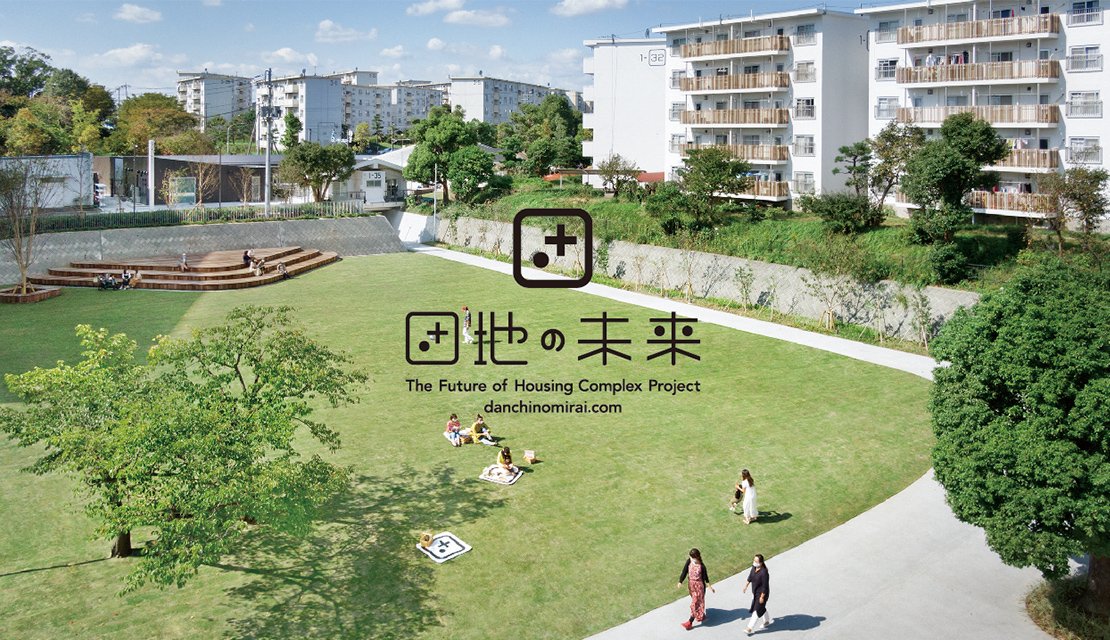JAPAN’S CONCRETE HOUSING: THE HISTORY OF DANCHI

HANA YORI DANCHI: SOVIET CHIC TO HOUSE THE CORPORATE SAMURAIS
Literally translating into “communal” or “group land”, danchi housing complexes are a household name or, more precisely, a well-known scenery to anyone who has ever encountered Japanese pop culture. The iconic scene from Neon Genesis Evangelion where Shinji visits Rei in her depressingly drab apartment is symbolic of the image danchi had after their heyday in the 1960s: outdated, dilapidated, sterile, deserted.
Danchi illustrations capturing the dilapidated, danchi to community housing projects narrative from the Neon Genesis Evangelion episode with Rei I.
Once celebrated as the onset of a modern lifestyle for nuclear families after World War II, danchi are often referred to as “Japan’s largest social housing experiment” with tenants back then connecting in regular community meetings, circulating informative leaflets, sharing milk and sugar just as much as chores to keep the facilities clean.
In recent years, danchi are mostly connected to gruesome news reports of kodokushi, lonely deaths of elderly residents. They are often reduced to skeletons or bug-infested mush before neighbors, distant relatives or facility managers literally catch a smell.
Worker clearing out apartment of elderly who had been found dead after some time.
It would be easy to dismiss the seemingly outdated danchi as a gloomy death trap for those who missed a chance to move out to trendy metropolitan areas or to lavish suburban family homes. Yet, there is a countermovement fueled by young urbanites, a changing work-life-balance and, last but not least, by famous architects like Kengo Kuma who look to revive danchi complexes.
Elderly found in danchi apartment among belongings and garbage, where their body decomposed via melting.
Hana Yori Danchi is something we borrowed from the famous Japanese idiom “hana yori dango”, meaning “function over aesthetics” – which is pretty much the essence of these quickly raised, almost soviet-looking, bleak building complexes.
After 1945 war-ridden Japan experienced an immense housing shortage and needed to build 3 million homes, fast. Countless urban families had lost their houses in the war and were then often confined to 1-room apartments with an average of 4.5 tatami mats, roughly 7.5㎡. Cities also looked for quick solutions to accommodate workers who flocked from the countryside to urban areas to pursue employment and a modern lifestyle.
A typical danchi complex was usually built in the outskirts of existing city hubs like Tokyo by the so-called Japan Housing Corporation, founded in 1955. Japanese families oh-so-happily entered lotteries to be allotted a rental apartment unit. In mid-60s Tokyo there was a meager 1 in 145 chance of winning a tenancy and some families reportedly entered 13 times or more until they finally got a chance to move into one of these embodiments of middle-class aspirations.
Four to five stories tall, apartments of roughly 40㎡ with up to 3 rooms separated by sliding doors and equipped with modern appliances that were out of reach for most Japanese directly after the war: a bathtub, a fridge, a washing machine, a TV set, rice cooker and other newfangled gadgets. Life in a danchi was designed to manifest the ideal of a new middle class with perfectly happy nuclear families in standardized homes with standardized appliances, working hard and consuming a lot in order to boost the economy.
TV infomercials back then surely not only documented the equipment of a danchi but also strongly conveyed a socially desirable lifestyle infused by the conservative government.
In retrospect, some segments do feel more like propaganda than a simply informative how-to guide for new or aspiring residents. One of these commercial films shows a young married couple visiting an older sibling already living in a danchi with his little family. The protagonists explain all the facilities via voice-over, woven into the story of an average day at a danchi. It’s all about the conveniences, rules, duties, mutual considerateness – and how to avoid death by gas poisoning in the living room in winter.
Researchers argue that the social experiment of a thriving, egalitarian community was a failure by design due to the emphasis on consumerism, which perpetually fed into a “my home is my castle”-egoism, eventually cementing class differences.
Community meeting/gathering among danchi residents during the 60s.
The downfall of the danchi began as quickly as they had sprung up. Housing shortages eased from the mid-1970s onwards and habits of the next generation of young adults were significantly different from the war generation. Urban lifestyles filled with academic career paths, leisure activities and trendy-glitzy new mansions in the big cities became more and more attractive.
The 1980s with their economic bubble saw the rise of the urban yuppie, working hard, partying harder, marrying later, and living alone as singles for a substantially longer span of their life. Simply paying for facility management was without a doubt more comfortable for urbanites than performing community chores in cramped danchi complexes.
Even the Japan Housing Corporation began shifting its focus away from mass production of danchi towards land development in the midst of large cities and building new city centers close to industry heavyweights in more rural areas.
In 2004 the Corporation was semi-privatized and re-branded as the Urban Renaissance Agency. It still tackles urban housing issues today, now with a focus on Japan’s falling birth rate, a super-aging society, environmental problems, and the provision of emergency public housing for disaster-stricken areas.
Renovating and rejuvenating old JHC housing stock, including danchi, are also on the agenda. In a 2016 pamphlet the Agency vowed to develop “cities where people of all generations can live vibrant lives”, looking to establish real communities featuring medical and welfare centers, barrier-free access, and mixed communities – age wise but yes, foreigners also welcome! The Agency’s application process is not only foreigner-friendly but on top of that it is cheaper than an average new contract with private housing companies that easily charge 5 to 6 months’ worth of monthly rent for fees + deposits when initially moving in.
Commonly reformed danchi apartments from the inside to attract new renters.
The Urban Renaissance Agency really spares no effort to shake off the stuffy image of danchi. It not only hands out rental discounts to families with young children or family members of elderly people living within the same housing complex.
Collaborations with modern interior powerhouses IKEA and MUJI were also forged to renew apartments all over Japan in order to attract young and hip tenants. The Agency’s website furthermore boasts DIY YouTube tutorials to enable tenants to renovate and personalize their danchi apartment, feeding on a general DIY trend that has gripped Japan even stronger since the global CoVid crisis has begun.
Urban Renaissance Agency & MUJI renovations.
Some danchi rejuvenation projects even go way beyond furniture, fresh paint or the installation of elevators. They look to reinvigorate a true sense of community and deep connection between tenants but also between humans and their environment.
The renovation of the Yokodai Danchi, south-west of Tokyo, is ambitiously called “The Future of DANCHI” project and directed by renowned architect Kengo Kuma. While the original danchi were aimed to relieve an urgent housing shortage in a functionally adequate manner, Kuma and the Urban Renaissance Agency now frame danchi as thriving, mixed community spaces not only for residents but for anyone who stops by.
BEFORE
AFTER
Kuma and his associates took the bleak, uninviting structures and began to fill them with lots of greenery, adding natural, soft materials such as wood to balconies and by creating a communal space including a coffee shop on top of the formerly blank stone stairs.
Another large danchi complex in northern Tokyo offers anything a modern, vintage-loving urbanite longs for: shared vegetable gardens, shared storages for BBQ or outdoor equipment, yard sales by local bakeries, and a shared workshop including guest craftsmen to instruct residents on DIY projects.
It’s hard to tell whether the “new life” in these redeveloped danchis will be sustainable or if the children of today’s young tenants will also leave the danchi behind to follow other dreams. But one thing is sure: danchi nostalgia is deeply ingrained in the country’s collective memory, as it is still a recurring element in Japanese pop culture, from books to movies to anime, drama series and TV variety shows.
Just in 2018 the dark, creepy TV series Genkai Danchi addressed the dichotomy of “good old days in a 60s danchi” vs “the reality of life in a rather worn-down complex” with lonely elderly people, isolated housewives, egoistic and disillusioned tenants … and a 60-something grandfather who resorts to all kinds of sinister means to clean up his danchi to restore the peaceful community he once knew as a danchi inhabitant back in the days.
Large residential complexes like the danchi are not limited to Japan as prefabricated large-scale housings had also been developed in the Soviet Union between 1950 and 1970 – and it’s also easy to see similarities with Paris’ notorious banlieues. Even the newfound interest in redevelopment and more sustainable, slower city life is a global phenomenon. Since the 2000s delegations of Japanese architects have repeatedly visited Germany to learn from local experts who are engaged in similar renovation projects to modernize particularly Eastern German „plattenbau“ complexes. Preservation efforts in Japan, specifically in Tokyo, might run into one typical problem though: the city’s penchant for demolishing buildings instead of renovating, even its most noteworthy architectural landmarks such as Harajuku station or Frank Lloyd Wright’s Imperial Hotel, which were bulldozed and rebuilt ahead of the Olympic games.
Text By: Jen Duermeier is a brand communicator by day and a polyglot writer by night. She’s obsessed with Japanese fashion, photography, variety TV and all things Shōwa. Never not thinking about moving back to her hood in Adachi-ku, she is always looking for good excuses and collaborations to go back and forth between Tokyo & Munich.






































